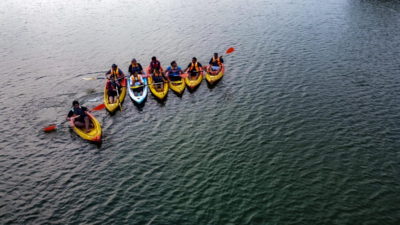Starlight, still waters and the lure of the mangroves | Chennai News – Times of India

A five-hour drive from Chennai, the mangroves of Pichavaram stretch across 1,400 hectares between the Vellar and Kollidam estuaries in Cuddalore district. For decades, mangroves were largely ignored, the spaces seen as nothing more than extensions of the sea.Besides fishing, there were no other economic activities linked to these landscapes.Today, that image is changing. Stand-up paddler Kumaran Mahalingam, founder of the Mangrove Bay Eco Camp, has been training visitors in kayaking and paddling at Pichavaram for three years. “Slow-moving non-motorised boats and water sport activities help people appreciate the mangroves,” says Kumaran.Pichavaram is gaining attention as a site for stargazing too. Bhavanandhi, founder of Star Voirs, an organisation that conducts astronomy workshops, says the region’s clear skies make it ideal for night-sky observations. “Light and industrial pollution make stargazing difficult in places such as Chidambaram. But Pichavaram has none of those drawbacks,” he says.Recognised as part of the Central Asian Flyway, Pichavaram is also a hotspot for birders. “Between Oct and Feb, we record more than 20,000 birds, mostly small wading species,” says Jamil Hussain Ibrahim, a doctoral researcher from Thiruvalluvar University who studies the region. Efforts by the forest department to expand mangrove cover using the ‘fish bone method’, a technique of planting saplings along canal-like trenches, are also influencing bird activity.“The habitat changes are creating seasonal variations in bird sightings,” he says.R Jayasurya, a researcher who studies otter populations in the region, says the shy mammals prefer calm, shaded environments. “The noise and pollution from motorboats can disturb their movements and drive them away,” he says.The benefits go beyond sightings. Otters depend on fish as their primary food source, and cleaner backwaters support aquatic life. “By avoiding fuel-powered boats, we protect the food chain,” says Jayasurya.While the forest department has demarcated a portion of the mangroves as reserve forest, tourism activities are restricted to the buffer zone. Boat rides are managed by the tourism department. “But the lack of coordination between the tourism and forest departments is getting in the way of tapping into the full ecotourism potential of the region,” says Jamil.Efforts are on to better involve local communities more. Kumaran has trained three local fishermen, who now help manage the eco camp. “Local participation will help with long-term conservation,” he says.A recent report by Anna University, ‘Blue carbon monitoring for mangroves of Tamil Nadu’, shows the state’s mangrove cover has doubled in just three years — from 4,500 hectares in 2021 to 9,039 hectares in 2024. The Cuddalore region, of which Pichavaram is a part, stores the highest amount of carbon per hectare in TN. It stores 249 tonnes of carbon a hectare.From 1930 to 1994, the degraded mangrove cover had grown from 70 hectares to 565 hectares because of various reasons.Unregulated cattle grazing and tree felling had severely damaged the ecosystem. Studies by M S Swaminathan Research Foundation (MSSRF) found a forest management system known as ‘coupe felling’, where trees are harvested every 20 or 30 years for revenue, damaged the mangrove. By exposing large areas to direct sunlight, the practice led to soil water evaporation and an increase in salinity levels, making regeneration almost impossible.Regeneration efforts in Pichavaram began in 1994, when MSSRF, in collaboration with the state forest department, launched a programme to restore the degraded mangroves. But public recognition of the importance of mangroves came only in the wake of natural disasters such as the tsunami in 2004 and Cyclone Thane in 2011.Described as “nature’s shield” mangroves buffer coastal communities against cyclones and tidal surges. They also prevent soil erosion, purify water and absorb carbon dioxide.In the aftermath of the tsunami, TN implemented a dedicated mangrove conservation project in 2005-2006. In 2022, the Pichavaram mangrove forest was designated a Ramsar site, marking it as a wetland of international importance. More recently, funds have been allocated under the TN-SHORE mission for conservation.“Teaching people to appreciate the mangrove ecosystem and tapping into its ecotourism potential can ensure its long-term protection,” says R Ramasubramanian, senior fellow, coastal systems research at MSSRF. “In western countries, tourists who visit mangroves do fishing and cook their own catch. That kind of culture needs to pick up here.”“Though Puducherry’s mangroves also have water sports facilities, the river there is highly polluted because of industrial effluents. That gives Pichavaram an edge when it comes to ecotourism.”The govt is taking efforts to tap the ecotourism potential in mangroves, says Supriya Sahu, additional chief secretary, environment, climate change and forests department.“Pichavaram was chosen under the climate change programme. Similarly, in Muthupet mangroves in Nagapattinam, we have constructed a jetty and started boating. Soon we will have eateries and play areas,” she says. “We are exploring a range of boats starting from traditional boats to solar-powered boats which can minimise any kind of pollution and at the same time provide a better tourist experience.”
















